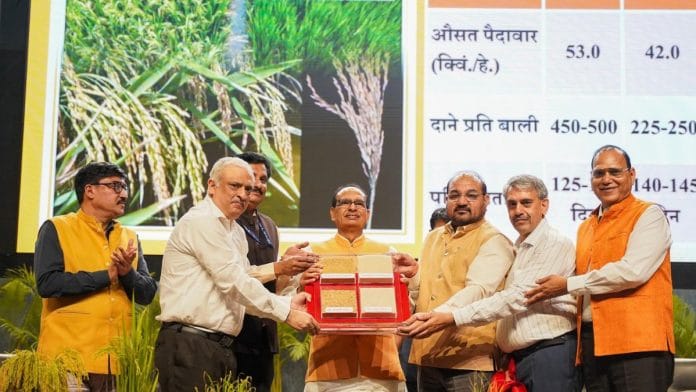New Delhi: The world’s first genome-edited rice varieties, developed by the Indian Council of Agricultural Research (ICAR), mark a leap towards a new generation of climate-resilient crops. Not only do they promise increased yields, they also offer India a route around genetically modified grains.
Union Agriculture Minister Shivraj Chouhan launched two genome-edited rice varieties Sunday—one developed by the Hyderabad-based Indian Institute of Rice Research (IIRR), and the other by the Indian Agricultural Research Institute (IARI) in Delhi.
ICAR director M. L. Jat told ThePrint that the two varieties—DRR Rice 100 (Kamla) and Pusa DST Rice 1—have completed the all-India coordinated trials. Scientists bred improved genome-edited mutants of Samba Mahsuri and Cotton Dora Sannalu varieties using the CRISPR-Cas SDN-1 (Clustered Regularly Interspaced Short Palindromic Repeats Cas Site-Directed Nuclease-1) technology to create these variants. It is a type of genome editing technique in which the CRISPR-Cas system is used to introduce targeted mutations at a certain location in the genome without adding foreign genetic material.
“Before these varieties become available to farmers, they must undergo additional trials—foundation, breeder, and certified seed production tests,” Jat said.
ThePrint explains the significance of these new genome-edited crops.
Also Read: 47 yrs ago, this Indian-origin physicist asked Feynman a question. He hasn’t looked back since
Difference between GMOs & genome-edited crops
Genetically modified organisms (GMOs) involve modifying an organism’s genetic material, say, plant DNA, by introducing foreign genetic material.
In GMO crops, genes are mined from soil bacteria and inserted into the host genome through genetic engineering. This process has faced criticism, with many agriculturists and scientists raising concerns over its health, safety, and ethical implications, as it alters a plant’s genetic makeup by introducing foreign material.
For instance, developing genetically modified cotton (Bt cotton) involves inserting a gene from the bacterium Bacillus thuringiensis (Bt) into the native cotton plant’s genome. These genes, cry1Ac and cry2Ab, enable the plant to generate endotoxins that increase resistance to specific pests and plant diseases.
Genome editing, however, involves ‘editing’ rather than ‘modifying’ plant genes. This means no foreign genes are introduced; instead, the plant’s existing genes are altered to promote mutations within its DNA sequence. This makes genome editing a safer, healthier, and environmentally friendly option.
Senior agriculture scientist A.K. Singh, former director of the IARI, said the new rice varieties were developed using CRISPR-Cas genome editing technology, which makes precise changes to the plant’s native genes without introducing any foreign material.
Genome editing using SDN 1 and SDN 2 types—methods under the broader umbrella of Site-Directed Nuclease (SDN) technologies—has been approved under India’s biosafety regulations for general crops. SDNs are engineered enzymes which can cut DNA at specific and predetermined locations within a genome, and are used in gene editing to introduce targeted changes.
“Imagine this like a photo editing tool, which enhances specific features and brings out desirable attributes,” Singh explained.
The new variants
ICAR scientists said genome-editing research began in 2018, aiming to improve existing rice varieties—Samba Mahsuri and MTU 1010—by enhancing yield and making them more environmentally viable.
Samba Mahsuri, also known as BPT5204, is a popular fine-grain rice variety grown in Andhra Pradesh, Tamil Nadu, Telangana, West Bengal, and parts of Uttar Pradesh. MTU 1010, another high-yielding, short-duration variety, is cultivated in Andhra Pradesh, Telangana, Odisha, and West Bengal, and is popularly called Cotton Dora Sannalu.
Initial tests on the genome-edited varieties—DRR Rice 100 and Pusa DST Rice 1—have shown promising results, the Union Agriculture Ministry said. The crops demonstrated 19 percent higher yields, a 20 percent reduction in greenhouse gas emissions, saved approximately 7,500 million cubic metres of irrigation water, and improved tolerance to drought, salinity, and climate stresses.
A senior ICAR scientist explained that the Kamla variety is a super short-duration variety, maturing in just 125 to 130 days—around 20 days earlier than its parent, Samba Mahsuri.
“All the positives of Samba Mahsuri are present in Kamla. It has the same grain length and cooking quality,” the scientist said.
Due to its shorter maturation, the variety conserves water and fertilisers, and reduces methane emissions.
“Its stalk is strong and does not fall,” the scientist added.
Pusa DST Rice 1—short for drought and salt tolerant—derived from MTU 1010, retains the original variety’s attributes while adding resilience to drought and saline stress.
According to ICAR, this variety can boost yields by 9.66 percent to 30.4 percent in saline and alkaline soils, with potential for up to a 20 percent increase in overall production.
States including Andhra Pradesh, Telangana, Karnataka, Tamil Nadu, parts of Kerala, Puducherry, Chhattisgarh, and Maharashtra are expected to cultivate this variety in the coming years.
Officials from the Union Ministry of Environment, Forests and Climate Change (MoEFCC) told ThePrint that India has exempted genome-edited crops from biosafety regulations under the Environment (Protection) Act, 1986.
This exemption is because genome-edited variants do not introduce foreign genes into the host crop’s DNA, and therefore their ‘release’ into the environment carries negligible risk, according to ICAR.
The way forward
ICAR scientists continue genome-editing research on other crops, including pulses and oilseeds.
In the Union Budget 2023-24, the government allocated Rs 500 crore for genome-editing breeding and research on agricultural crops.
Experts said India has taken a much-needed step towards climate-resilient agriculture.
Matthew A. Schnurr, a Canada-based environmental geographer and assistant professor in the Department of International Development Studies at Dalhousie University, told ThePrint that plant improvement will become a key strategy for adapting cropping systems to climate change.
“Climate change will impact smallholder agricultural systems in ways that are both dramatic and unpredictable. These methods are a way forward to make agriculture more climate resilient,” Schnurr said.
(Edited by Radifah Kabir)
Also Read: Search for an Indian Carl Sagan is on. Science influencers are being trained in labs and likes






